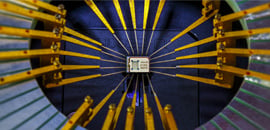MicroE’s PurePrecision™ technology has been the core optical technology platform leveraged by MicroE to deliver precision optical encoders to the market that are significantly smaller and easier to align and install than competitive products.
The Challenge
As robots and machines become more sophisticated and are called upon to perform more complex tasks, the motion control that defines their movements must be as precise as possible to avoid accidents, prevent mechanical failures, and increase throughput.
System designers face many difficult challenges and constraints. Minimizing the size and weight of motion control components is often necessary to meet system design requirements. Integrating adjacent components into an optimized assembly is increasingly required to meet performance and cost targets. With machines and humans interacting on an increasing scale, reliability is more critical than ever before.
MicroE has been designing miniature encoder products and working closely with OEMs to engineer highly optimized motion control solutions in the most demanding applications for over 20 years. MicroE’s wide range of miniature optical encoders, depth of application expertise and proven reliability enabled leading OEMs to achieve the design goals of their next generation systems.
The Solution: PurePrecision™ Technology
For over 20 years, MicroE’s innovative and patented PurePrecision™ technology has been the core optical technology platform leveraged by MicroE to deliver precision optical encoders to the market that are significantly smaller and easier to align and install than competitive products. MicroE’s PurePrecision technology has enabled designers of precision motion control systems in medical, semiconductor, advanced industrial and scientific applications to design smaller, lighter and more energy efficient machines and instruments. PurePrecision technology is particularly well suited for applications where the encoder is installed in controlled environments that require compact sensor size, small overall footprint and high accuracy associated with glass gratings.
PurePrecision™ optical encoder technology is a patented, laser-based, reflective diffraction technique unique to MicroE. It utilizes a basic principal of optical diffraction called Talbot Imaging. PurePrecision™ optics require no intermediate lenses, filters or reticles which allows MicroE to create the industry’s smallest high resolution optical encoders with extremely generous alignment tolerances.
How PurePrecision Works
Encoders work by sensing the relative position of a sensor to that of a scale or grating. MicroE produces non-contact optical “kit encoders”, where the sensor and grating are individually installed into a machine element with a pre-existing bearing structure. The sensor head emits a light source, which reflects off the grating, and is collected by the detector also residing in the sensor head. The result is a train of pulses which can be used to determine position and speed.
The information below provides insight into principles behind the MicroE innovations that result in the smallest encoders in comparison to its competitors

Position Track
A coherent light source is required. MicroE uses a VCSEL (vertical cavity surface emitting laser) for its extremely small size, low power consumption and stable operation. This laser creates a diverging beam which illuminates a diffraction grating pattern printed on the scale. The grating pattern is created using either chrome deposition on a glass scale or laser written lines on a metal tape scale. A 20µm pitch diffraction pattern (10µm line, 10µm space, etc.) is most commonly utilized, though some products use 40µm pitch diffraction pattern (20µm line, 20µm space, etc.). This is an amplitude grating which diffracts the light to generate a high contrast interference pattern of bright and dark directly back onto a highly specialized detector array (see Figure 2). The detector cell widths are optimized to reject undesirable orders of diffraction.

The diffracted light generates discrete Talbot planes of constructive interference where the detector can be placed. As the relative position of the scale and detector changes, this diffraction pattern translates across the detector array resulting in a sinusoidal change in each detector cell. In the example illustrated in Figure 1, the 3rd Talbot plane is utilized. Every 20µm on the detector, there are four cells or quads. Each cell of the detector generates one of four sinusoidal signals with a 20µm electrical period; Sin+, Cos+, Sin- or Cos- (See Figure 3). Identical cells are tied together electrically and fed into the sensor’s processing circuitry.

Index Track
The grating’s index mark, shown in Figure 2, behaves as a cylindrical lens which generates a single band of light aimed at the index detector cells. When the index mark is crossed, this band of light passes over the three detector cells (A, B, and C). Each of these cells generates an analog signal represented by the black traces in the diagram in Figure 4. These signals are mathematically combined as B minus A minus C as shown in the blue trace. The zero-crossings of this composite signal define the rising and falling edges of the digital Index Window signal shown in red. The spacing of the three detector cells are chosen to create a stable 20µm wide Index Window despite small variations in optical power.

PurePrecision technology has allowed MicroE to deliver precision optical encoders that are significantly smaller and easier to align and install than competitive products. The products built around this technology are best suited for relatively clean environments and typically demand high accuracy associated with glass gratings.
Key Products Lines Using PurePrecision Technology Include:







